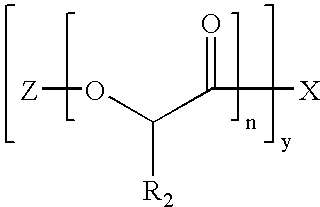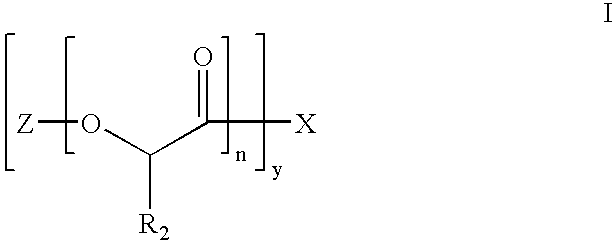Biocompatible Polymer Compounds For Medicinal Formulations
a biocompatible polymer and formulation technology, applied in the direction of organic active ingredients, dispersed delivery, aerosol delivery, etc., can solve the problems that many biocompatible polymers, such as oligolactic acids, can suffer from impaired stability in medicinal formulations, and achieve the effect of reducing stability
- Summary
- Abstract
- Description
- Claims
- Application Information
AI Technical Summary
Benefits of technology
Problems solved by technology
Method used
Image
Examples
example
Synthesis of N,N′-ethylenebis(acetyloligolactyl)amide
[0114]D,L-lactic acid (8.3 kg, Mashushino Chemical Co.) was place in a reactor and heated at 150° C. and 40 mbar pressure for 5 hours. After this time, the reaction was cooled to approximately 100° C. The vacuum was removed and the reaction was purged with nitrogen. 4.66 kg acetic anhydride (Fisher Scientific) was added and the reaction heated at 120° C. for 5 hours under a nitrogen purge. After this time, excess acetic anhydride and acetic acid were removed by distillation at 40 mbar and 120° C. To the reaction was then added 2.33 kg of 2-methyl-2-propanol (Sigma Aldrich). This was heated 80° C. for 9 hours under a nitrogen purge. Excess 2-methyl-2-propanol was then removed by distillation at 40 mbar and 120° C. The resulting molten, acetylated oligolactic acid was then heated at 160° C. and <10 mbar for four hours to pyrolyze any t-butyl esters. The product was then refined by passing it through a rolled film evaporator (feed ra...
PUM
| Property | Measurement | Unit |
|---|---|---|
| polydispersity | aaaaa | aaaaa |
| polydispersity | aaaaa | aaaaa |
| diameter | aaaaa | aaaaa |
Abstract
Description
Claims
Application Information
 Login to View More
Login to View More - R&D
- Intellectual Property
- Life Sciences
- Materials
- Tech Scout
- Unparalleled Data Quality
- Higher Quality Content
- 60% Fewer Hallucinations
Browse by: Latest US Patents, China's latest patents, Technical Efficacy Thesaurus, Application Domain, Technology Topic, Popular Technical Reports.
© 2025 PatSnap. All rights reserved.Legal|Privacy policy|Modern Slavery Act Transparency Statement|Sitemap|About US| Contact US: help@patsnap.com



